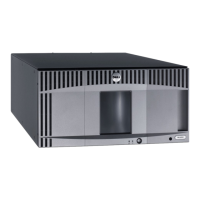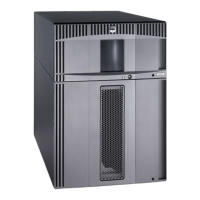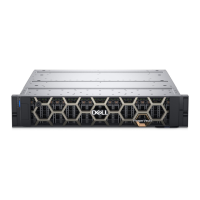Configuring Your Library
file:///T|/htdocs/stor-sys/ML6000/en/html/ch04.htm[9/17/2012 1:49:29 PM]
• NTP server IP addresses must be entered in the proper format. See Modifying Network Settings for the proper format
of IPv4 and IPv6 addresses.
• After you apply NTP settings, system clock synchronization may take several minutes.
You can only enable and configure NTP on the Web client. The path to open the appropriate screen is as follows:
• From the Web client, select Setup > Date & Time.
Setting the Time Zone
To select your time zone from a list, disable Use Custom Time Zone setting and select your time zone.
If your time zone does not appear on the list, or you want more control over your time settings, enable Use Custom Time
Zone and set a Universal Coordinated Time (UTC) offset.
You can only set the time zone on the Web client. The path to open the appropriate screen is as follows:
• From the Web client, select Setup > Date & Time.
Setting Daylight Saving Time
If you selected your time zone from the drop-down list (see Setting the Time Zone), the library automatically adjusts for
daylight saving time. There is no need to manually reset the clock for time changes.
However, if you set a custom time zone, the library will not automatically adjust for daylight saving time. You must enable the
Use Custom Daylight Saving Time setting. Once enabled, you can set start and stop times to an accuracy of one minute.
You can only set daylight saving time on the Web client. The path to open the appropriate screen is as follows:
• From the Web client, select Setup > Date & Time.
Working With FC I/O Blades
The library supports optional FC I/O blades, which provide host connections to LTO-3, LTO-4, and LTO-5 FC drives. The
number of FC I/O blades in any library configuration cannot exceed four, and each FC I/O blade in the library supports up to
four FC tape drives.
FC I/O blades reduce switch port and cabling requirements and increase backup reliability. When tape drives are connected to
FC I/O blades, the library proactively checks the status and readiness of the data paths from the hosts through the FC I/O
blade to the FC tape drives.
In addition, two powerful features provide ways to manage the interaction between hosts and target devices:
• Channel zoning allows you to control access between FC I/O blade ports configured for host servers and ports
configured for target devices. For more information, see
Configuring FC I/O Blade Channel Zoning.
• Host Mapping allows you to control visibility to target devices and access from individual host servers to target
devices. For more information, see Managing FC Hosts and Host Mapping.
The topics in this section cover configuring FC I/O blades. For additional information on FC I/O blades, see:
•
Fibre-Channel Input/Output Blades
•
Controlling FC I/O Blade Power
•
Viewing FC I/O Blade Information
•
Viewing FC I/O Blade Port Information
•
Connecting Library FC Cables to FC I/O Blades
•
Recommended Library Cabling for FC I/O Blades
•
Identifying FC I/O Blades
•
Resetting FC I/O Blade Ports
Note: FC I/O blade menu commands are available for use only when FC I/O blades are installed in the library.

